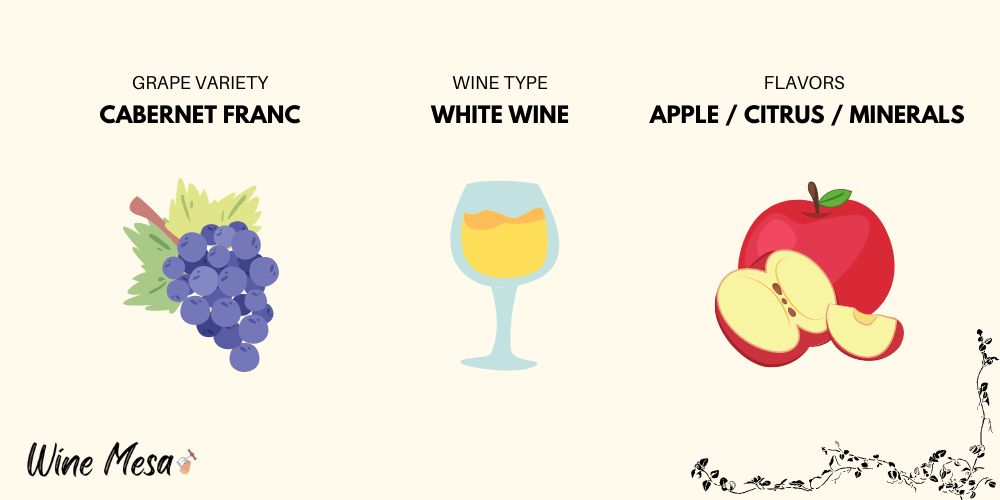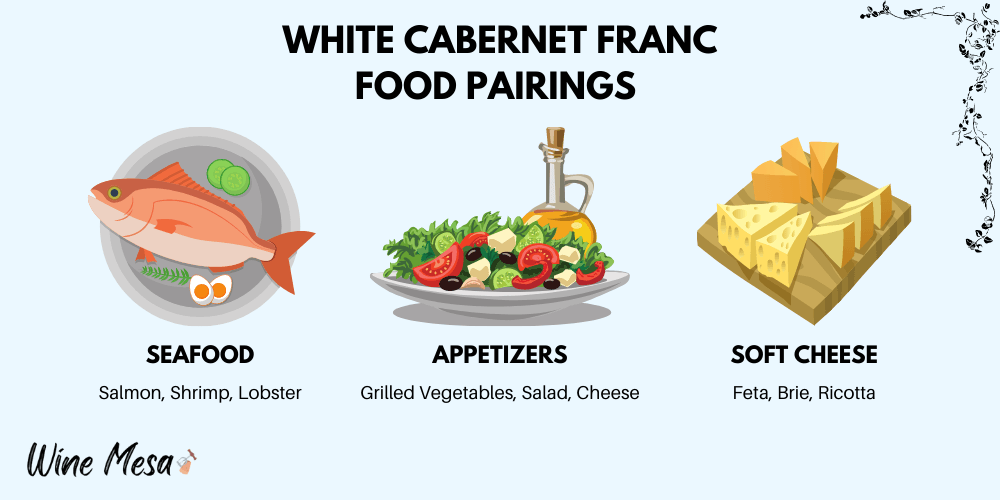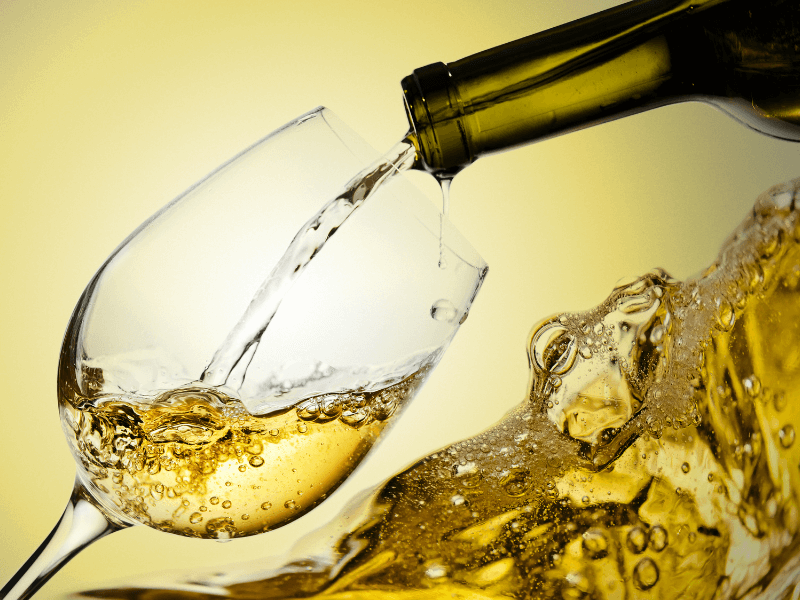“White Cabernet Franc” is a white wine made from the “Cabernet Franc” grape. It is typically dry and can be blended with other grapes, such as Semillon or Gewurztraminer.
The grape for “Cabernet Franc” originated in the Bordeaux region of France but is grown around the world today.
The grape was likely introduced to Australia by French missionaries in 1832 and soon became widely planted there.
Over time the grape’s cultivation spread throughout other regions, including California, Oregon, South Africa, Germany, Chile, New Zealand, and Canada.

What Does White Cabernet Franc Taste Like?
Typically this white Cabernet Franc has aromas of green apple with an underlying suggestion of peach. Common flavors are pear, quince, honeydew melon, lemon zest, and lime zest.
White Cabernet Franc pairs well with shellfish such as lobster or oysters. It also pairs with other seafood such as crab and shrimp, and lean poultry such as chicken or turkey.
The color of white Cabernet Franc is a pale yellow, which tends to deepen to a deeper golden-yellow hue as it ages. The wine’s acidity is generally high, giving the grape an ability to age well over time.
The finish is long, with moderate notes of minerality.
Best White Cabernet Franc Examples
Vincent Careme Tendre Vouvray 2018 – This sample has floral aromatics with hints of honeysuckle and oak balanced by crisp acidity and ripe pears on the palate. The body is “light” overall, but there is a bit more fullness toward the end due to the sweetness, which nicely rounds out the flavor profile. The finish leaves behind an aftertaste of apricot.
Virtue Cellars Purity Cabernet Franc Blanc – Tastes of apple, pear, and citrus with hints of vanilla. The body is light with high acidity. It has a fruity finish that leaves behind lingering notes of tangerine. The variety has enough acidity to pair well with foods, making it a good choice for pairing with lighter fare.
Haywood Cabernet Franc Blanc – Tastes of lemon curd with some tropical fruit flavors and candied grapefruit peel, butterscotch, honey, and grapefruit juice. Reviewers state that the texture may remind you more of a slightly sweet Riesling than a white Bordeaux. This is because it has ample glycerin (a thickening agent), contributing to its full mouthfeel.
Bodega del Desierto Mia Cabernet Franc Blanc de Noir Extra Brut – This wine tastes dried honey, pineapple, sandalwood, and baked apple. The body is medium with a good amount of acidity. Some reviewers have compared the flavor profile to an Alsatian Pinot Blanc, while others say that it’s more like a Chardonnay because it has a “flinty” note which would also indicate minerality.
Basel Blanc de Cabernet Franc – Tastes of green apple and pear with hints of grapefruit zest and fresh-cut grass. It, too, has some glycerin for fullness but has less than the Haywood variety. Reviewers find this wine crisp with an acidic finish that leaves very faint notes of white pepper on your palate after you swallow.
What Food Pairs with White Cabernet Franc?
White Cabernet Franc pairs well with appetizers like baked brie and goat cheese crostini. Examples of main dishes include herb-crusted salmon or roast chicken thighs.
Below are foods that pair well with White Cabernet Franc.

Seafood – The wine matches well with lighter seafood like salmon, halibut, and grouper. It can also pair well with shellfish like oysters, mussels, and clams.
Chicken – The earthy flavors of Cabernet Franc are best complemented by chicken cooked in a red wine sauce. It may go well with spiced dishes as well.
Cheese – White Cabernet Franc goes well with semi-firm, buttery cheeses like Gouda, Havarti, Fontina, and Monterey Jack. It can pair well with medium-aged hard cheeses too.
Vegetables– This wine complements grilled vegetables, roasted veggies, and creamy cauliflower puree.
Appetizers – This wine pairs nicely with appetizers that are not too overpowering. Goat cheese crostini, baked brie, watermelon salad, summer fruit trifle
Grilled Steaks and Chops – This white wine pairs well with dishes like barbecued beef ribs, veal meatballs, and flank steak salad.
Is White Cabernet Franc Sweet or Dry?
White Cabernet Franc wines are usually dry, but they have very low acidity. They may be described as having floral aromas and flavors of honeydew melon or pineapple.
Fruit flavors include apple and citrus fruits such as lemon or grapefruit. There may sometimes be herbal notes like thyme or rosemary.
How is White Cabernet Franc Made?
White Cabernet Franc is made using the same process as red wines.
The grapes are first fermented until dry. At this stage, they are called “white wine must.” Sulfur dioxide may be added to allow the winemaker to control the yeast fermentation rate better.
This helps prevent an excess of residual sugar from being present in the final product.
If too much sugar is left behind, it will result in a sweeter wine with less flavor complexity.
Next, the wine is filtered to remove any sediments formed during fermentation but leave behind polyphenols, tannins, and color pigments that contribute to the mouthfeel.
Finally, cold stabilization occurs when freezing temperatures help precipitate tartrates that can affect taste quality if not removed before bottling.
The wine is then fined to remove cloudiness by adding substances that either absorb proteins or surround them. This helps clarify the white wine.
The wine is then bottled and shipped off.
It may or may not be cold-stabilized again before being released to the market for sale. The cold stabilization process can remove some of the aromas present in the wine, so wines are only subjected to cold stabilization if they will benefit from it.
Summary
White Cabernet Franc wines are clear, dry white wines with low acidity.
The best examples have flavors of citrus fruits and honeydew melon.
They are best paired with appetizers that are not overpowering or food dishes cooked in red sauce.
The wine itself is made using the same process used to make red wines. It is usually cold-stabilized again before being released for sale to remove any aromas lost in the cold-stabilizing process.
